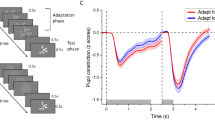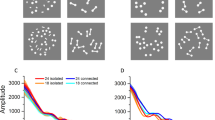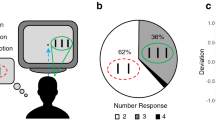Abstract
Thomas and Kendall1 have described experiments in which observers read books or magazines of their choice in various kinds of flickering light. Observers were asked to imagine that they were at home in the evening, and to indicate on a form whether, if the degree of flicker present during the 1 min of each test continued for the whole evening, they would consider it to be: not visible, perceptible, obvious, uncomfortable or intolerable. Three tungsten-filament lamps gave about 15 ft.-candles of illumination on the printed page. In one set of experiments a small proportion of the voltage to the lamps was made to fluctuate in a sine wave of three cycles per second. The reactions of observers to different magnitudes of this fluctuating voltage are shown in Table 1.
This is a preview of subscription content, access via your institution
Access options
Subscribe to this journal
Receive 51 print issues and online access
$199.00 per year
only $3.90 per issue
Buy this article
- Purchase on Springer Link
- Instant access to full article PDF
Prices may be subject to local taxes which are calculated during checkout
Similar content being viewed by others
References
Thomas, R. J., and Kendall, P. G., Inst. Elec. Eng. Conf. Rep. No. 8, 125 (1963).
Kendall, P. G., and Thomas, R. J., E. R. A. Report No. 5121 (Electrical Research Association, Leatherhead, 1965).
Fry, E., Reading Faster: A Drill Book (Cambridge University Press, Cambridge, 1963).
Thorndike, E. L., and Lorge, I., The Teachers' Word Book of 30,000 Words (Teachers College, Columbia University, New York, 1944).
Edwards, A. L., Amer. J. Psychol., 64, 598 (1951).
Poulton, E. C., Nature, 184, 1824 (1959).
Poulton, E. C., J. App. Psychol., 49, 358 (1965).
Broadbent, D. E., Handbook of Noise Control, edit. by Harris, C. M., chap. 10 (McGraw-Hill, New York, 1957).
Lloyd, V. V., Amer. J. Psychol., 65, 346 (1952).
Author information
Authors and Affiliations
Rights and permissions
About this article
Cite this article
POULTON, E., KENDALL, P. & THOMAS, R. Reading Efficiency in Flickering Light. Nature 209, 1267–1268 (1966). https://doi.org/10.1038/2091267a0
Issue Date:
DOI: https://doi.org/10.1038/2091267a0
Comments
By submitting a comment you agree to abide by our Terms and Community Guidelines. If you find something abusive or that does not comply with our terms or guidelines please flag it as inappropriate.



